Classroom Management and Behavioural Intervention Plans for Students
VerifiedAdded on 2022/09/08
|7
|1116
|14
Report
AI Summary
This report outlines a comprehensive classroom management plan and behavioral intervention strategies designed to create an effective and engaging learning environment. The plan emphasizes clear expectations, procedures, and interventions to address student behavior and improve academic performance. Part 1 focuses on establishing a mission statement and classroom expectations, including guidelines for student conduct, restroom use, tardiness, uniforms, and attendance. Part 2 details a behavior intervention plan with specific goals, interventions, responsible parties, and progress review notes. This section addresses issues like tardiness, lack of participation, and poor academic scores, offering interventions such as counseling, modified teaching styles, parent-teacher meetings, and awards. Part 3 presents a mini-action plan, highlighting interventions like student counseling and motivation techniques. The report underscores the importance of collaboration between teachers, students, and parents to support the implementation of these plans and enhance overall student development. The reference section provides a list of sources used in the report.
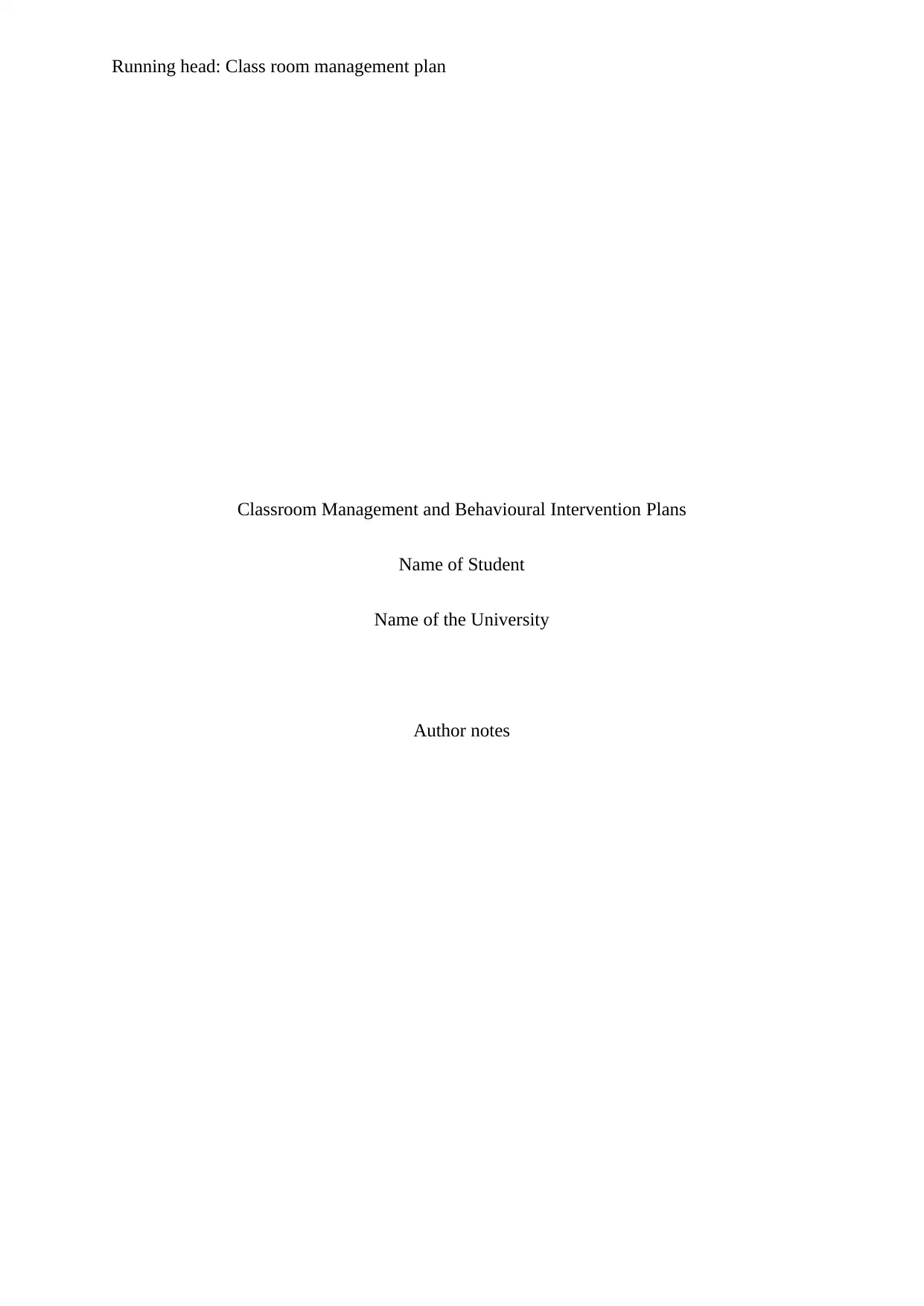
Running head: Class room management plan
Classroom Management and Behavioural Intervention Plans
Name of Student
Name of the University
Author notes
Classroom Management and Behavioural Intervention Plans
Name of Student
Name of the University
Author notes
Paraphrase This Document
Need a fresh take? Get an instant paraphrase of this document with our AI Paraphraser
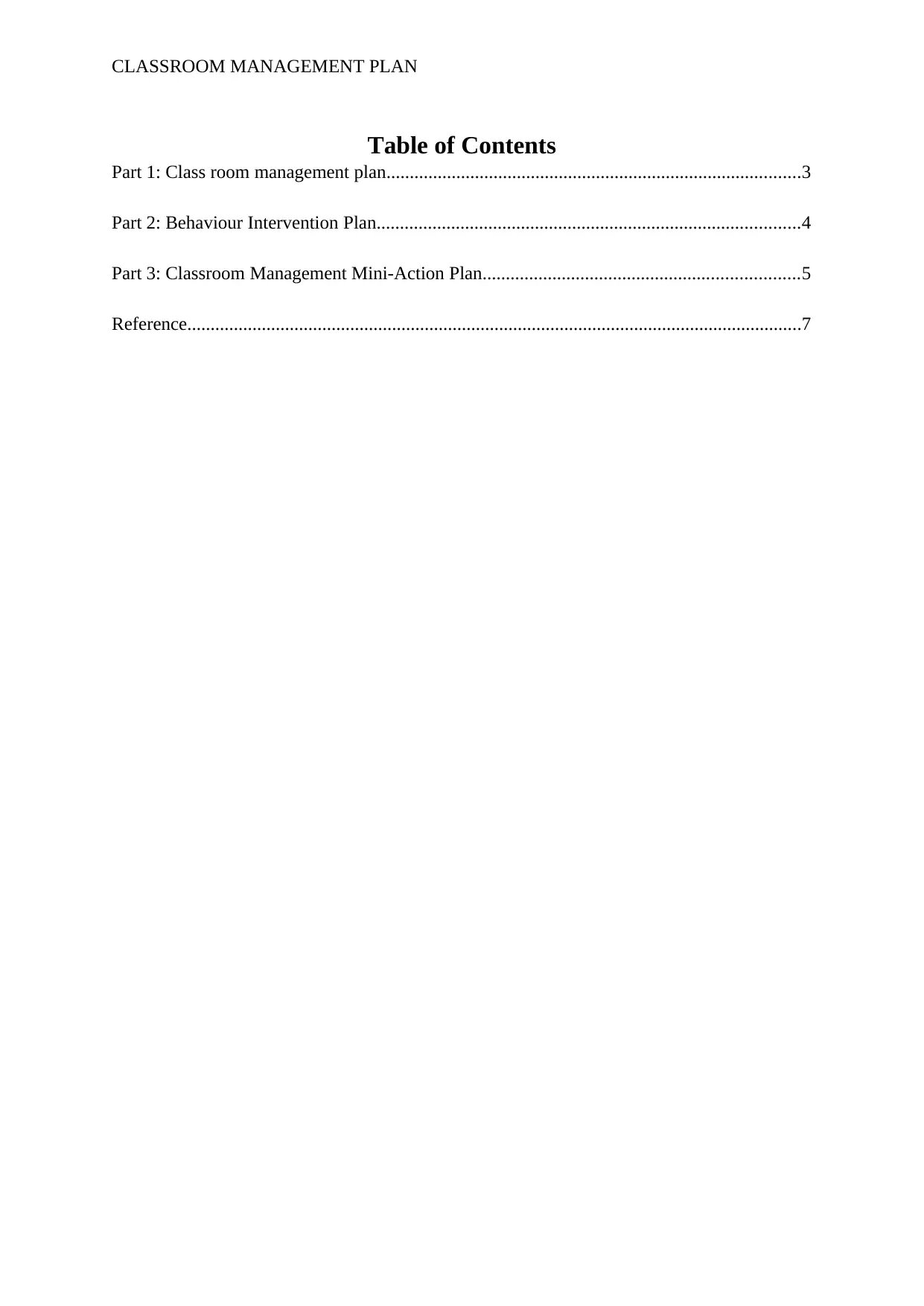
CLASSROOM MANAGEMENT PLAN
Table of Contents
Part 1: Class room management plan.........................................................................................3
Part 2: Behaviour Intervention Plan...........................................................................................4
Part 3: Classroom Management Mini-Action Plan....................................................................5
Reference....................................................................................................................................7
Table of Contents
Part 1: Class room management plan.........................................................................................3
Part 2: Behaviour Intervention Plan...........................................................................................4
Part 3: Classroom Management Mini-Action Plan....................................................................5
Reference....................................................................................................................................7
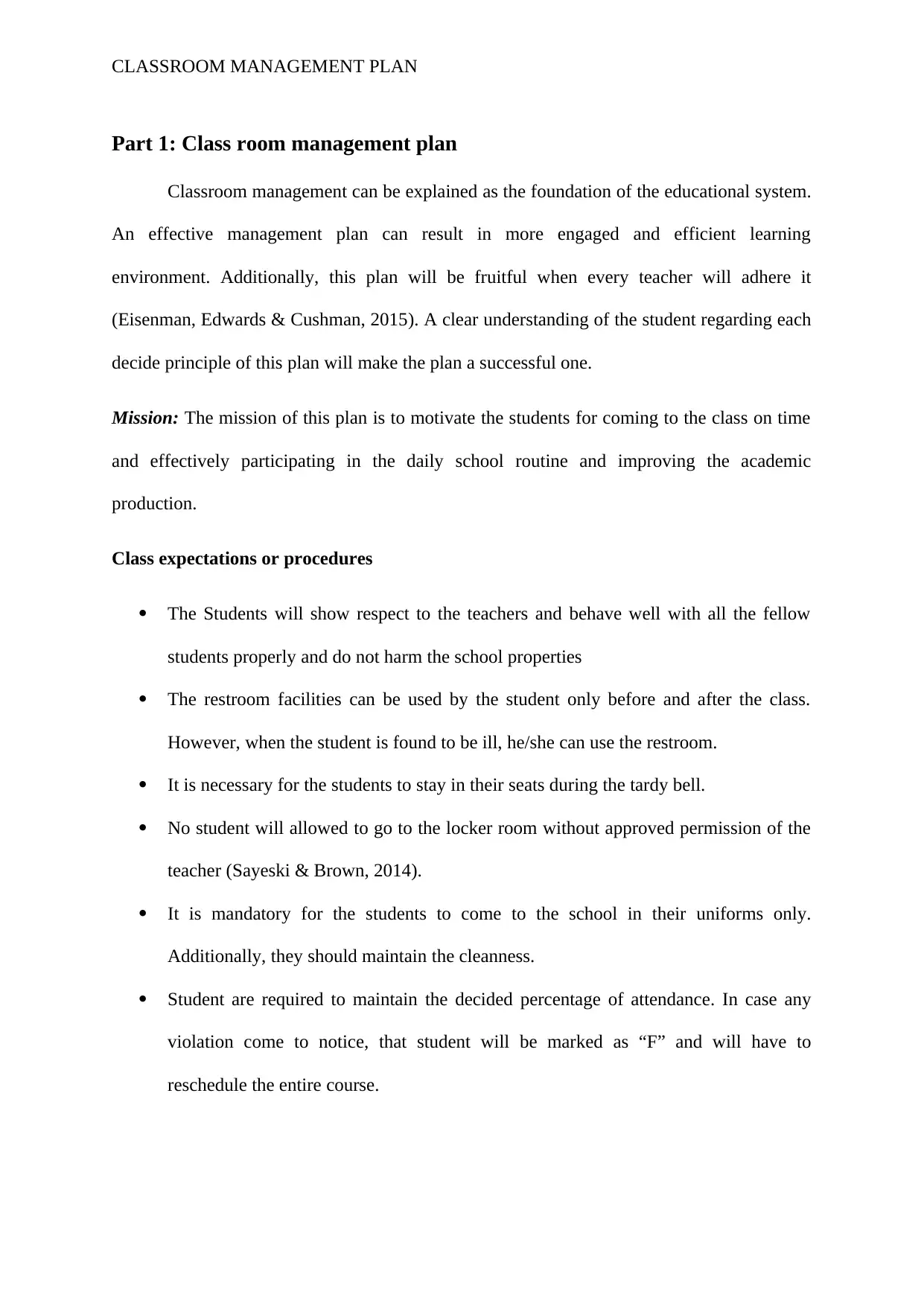
CLASSROOM MANAGEMENT PLAN
Part 1: Class room management plan
Classroom management can be explained as the foundation of the educational system.
An effective management plan can result in more engaged and efficient learning
environment. Additionally, this plan will be fruitful when every teacher will adhere it
(Eisenman, Edwards & Cushman, 2015). A clear understanding of the student regarding each
decide principle of this plan will make the plan a successful one.
Mission: The mission of this plan is to motivate the students for coming to the class on time
and effectively participating in the daily school routine and improving the academic
production.
Class expectations or procedures
The Students will show respect to the teachers and behave well with all the fellow
students properly and do not harm the school properties
The restroom facilities can be used by the student only before and after the class.
However, when the student is found to be ill, he/she can use the restroom.
It is necessary for the students to stay in their seats during the tardy bell.
No student will allowed to go to the locker room without approved permission of the
teacher (Sayeski & Brown, 2014).
It is mandatory for the students to come to the school in their uniforms only.
Additionally, they should maintain the cleanness.
Student are required to maintain the decided percentage of attendance. In case any
violation come to notice, that student will be marked as “F” and will have to
reschedule the entire course.
Part 1: Class room management plan
Classroom management can be explained as the foundation of the educational system.
An effective management plan can result in more engaged and efficient learning
environment. Additionally, this plan will be fruitful when every teacher will adhere it
(Eisenman, Edwards & Cushman, 2015). A clear understanding of the student regarding each
decide principle of this plan will make the plan a successful one.
Mission: The mission of this plan is to motivate the students for coming to the class on time
and effectively participating in the daily school routine and improving the academic
production.
Class expectations or procedures
The Students will show respect to the teachers and behave well with all the fellow
students properly and do not harm the school properties
The restroom facilities can be used by the student only before and after the class.
However, when the student is found to be ill, he/she can use the restroom.
It is necessary for the students to stay in their seats during the tardy bell.
No student will allowed to go to the locker room without approved permission of the
teacher (Sayeski & Brown, 2014).
It is mandatory for the students to come to the school in their uniforms only.
Additionally, they should maintain the cleanness.
Student are required to maintain the decided percentage of attendance. In case any
violation come to notice, that student will be marked as “F” and will have to
reschedule the entire course.
⊘ This is a preview!⊘
Do you want full access?
Subscribe today to unlock all pages.

Trusted by 1+ million students worldwide
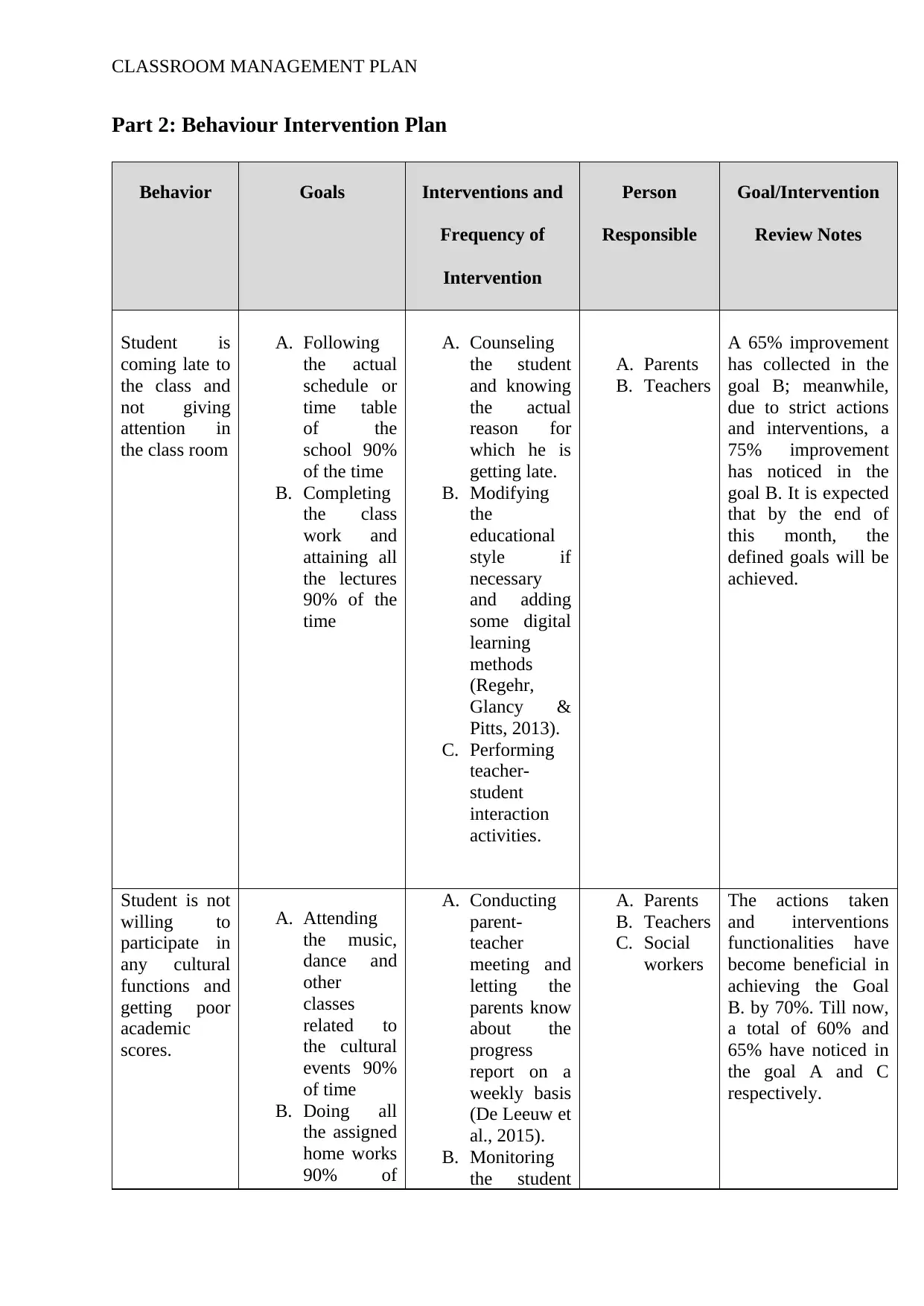
CLASSROOM MANAGEMENT PLAN
Part 2: Behaviour Intervention Plan
Behavior Goals Interventions and
Frequency of
Intervention
Person
Responsible
Goal/Intervention
Review Notes
Student is
coming late to
the class and
not giving
attention in
the class room
A. Following
the actual
schedule or
time table
of the
school 90%
of the time
B. Completing
the class
work and
attaining all
the lectures
90% of the
time
A. Counseling
the student
and knowing
the actual
reason for
which he is
getting late.
B. Modifying
the
educational
style if
necessary
and adding
some digital
learning
methods
(Regehr,
Glancy &
Pitts, 2013).
C. Performing
teacher-
student
interaction
activities.
A. Parents
B. Teachers
A 65% improvement
has collected in the
goal B; meanwhile,
due to strict actions
and interventions, a
75% improvement
has noticed in the
goal B. It is expected
that by the end of
this month, the
defined goals will be
achieved.
Student is not
willing to
participate in
any cultural
functions and
getting poor
academic
scores.
A. Attending
the music,
dance and
other
classes
related to
the cultural
events 90%
of time
B. Doing all
the assigned
home works
90% of
A. Conducting
parent-
teacher
meeting and
letting the
parents know
about the
progress
report on a
weekly basis
(De Leeuw et
al., 2015).
B. Monitoring
the student
A. Parents
B. Teachers
C. Social
workers
The actions taken
and interventions
functionalities have
become beneficial in
achieving the Goal
B. by 70%. Till now,
a total of 60% and
65% have noticed in
the goal A and C
respectively.
Part 2: Behaviour Intervention Plan
Behavior Goals Interventions and
Frequency of
Intervention
Person
Responsible
Goal/Intervention
Review Notes
Student is
coming late to
the class and
not giving
attention in
the class room
A. Following
the actual
schedule or
time table
of the
school 90%
of the time
B. Completing
the class
work and
attaining all
the lectures
90% of the
time
A. Counseling
the student
and knowing
the actual
reason for
which he is
getting late.
B. Modifying
the
educational
style if
necessary
and adding
some digital
learning
methods
(Regehr,
Glancy &
Pitts, 2013).
C. Performing
teacher-
student
interaction
activities.
A. Parents
B. Teachers
A 65% improvement
has collected in the
goal B; meanwhile,
due to strict actions
and interventions, a
75% improvement
has noticed in the
goal B. It is expected
that by the end of
this month, the
defined goals will be
achieved.
Student is not
willing to
participate in
any cultural
functions and
getting poor
academic
scores.
A. Attending
the music,
dance and
other
classes
related to
the cultural
events 90%
of time
B. Doing all
the assigned
home works
90% of
A. Conducting
parent-
teacher
meeting and
letting the
parents know
about the
progress
report on a
weekly basis
(De Leeuw et
al., 2015).
B. Monitoring
the student
A. Parents
B. Teachers
C. Social
workers
The actions taken
and interventions
functionalities have
become beneficial in
achieving the Goal
B. by 70%. Till now,
a total of 60% and
65% have noticed in
the goal A and C
respectively.
Paraphrase This Document
Need a fresh take? Get an instant paraphrase of this document with our AI Paraphraser
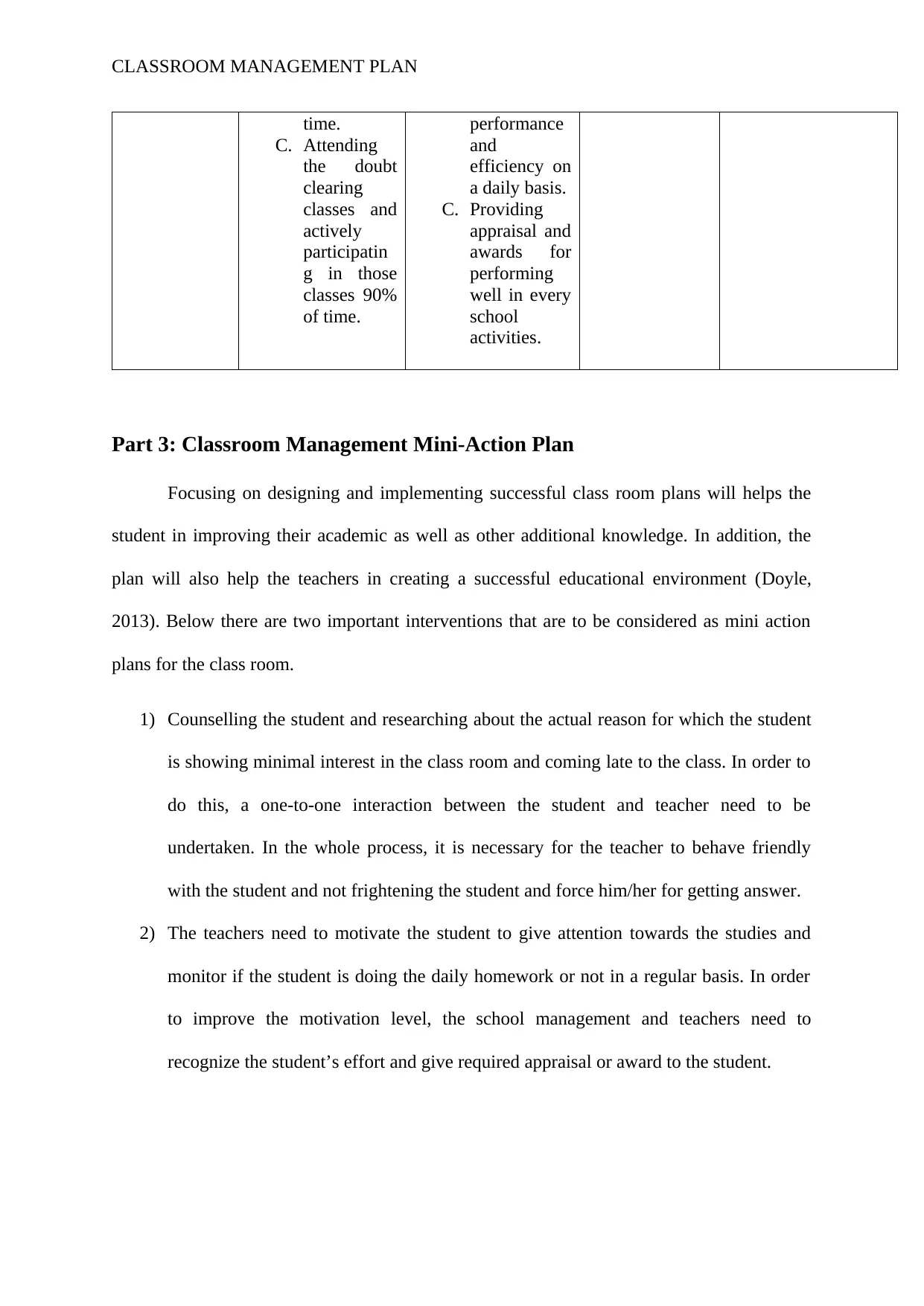
CLASSROOM MANAGEMENT PLAN
time.
C. Attending
the doubt
clearing
classes and
actively
participatin
g in those
classes 90%
of time.
performance
and
efficiency on
a daily basis.
C. Providing
appraisal and
awards for
performing
well in every
school
activities.
Part 3: Classroom Management Mini-Action Plan
Focusing on designing and implementing successful class room plans will helps the
student in improving their academic as well as other additional knowledge. In addition, the
plan will also help the teachers in creating a successful educational environment (Doyle,
2013). Below there are two important interventions that are to be considered as mini action
plans for the class room.
1) Counselling the student and researching about the actual reason for which the student
is showing minimal interest in the class room and coming late to the class. In order to
do this, a one-to-one interaction between the student and teacher need to be
undertaken. In the whole process, it is necessary for the teacher to behave friendly
with the student and not frightening the student and force him/her for getting answer.
2) The teachers need to motivate the student to give attention towards the studies and
monitor if the student is doing the daily homework or not in a regular basis. In order
to improve the motivation level, the school management and teachers need to
recognize the student’s effort and give required appraisal or award to the student.
time.
C. Attending
the doubt
clearing
classes and
actively
participatin
g in those
classes 90%
of time.
performance
and
efficiency on
a daily basis.
C. Providing
appraisal and
awards for
performing
well in every
school
activities.
Part 3: Classroom Management Mini-Action Plan
Focusing on designing and implementing successful class room plans will helps the
student in improving their academic as well as other additional knowledge. In addition, the
plan will also help the teachers in creating a successful educational environment (Doyle,
2013). Below there are two important interventions that are to be considered as mini action
plans for the class room.
1) Counselling the student and researching about the actual reason for which the student
is showing minimal interest in the class room and coming late to the class. In order to
do this, a one-to-one interaction between the student and teacher need to be
undertaken. In the whole process, it is necessary for the teacher to behave friendly
with the student and not frightening the student and force him/her for getting answer.
2) The teachers need to motivate the student to give attention towards the studies and
monitor if the student is doing the daily homework or not in a regular basis. In order
to improve the motivation level, the school management and teachers need to
recognize the student’s effort and give required appraisal or award to the student.
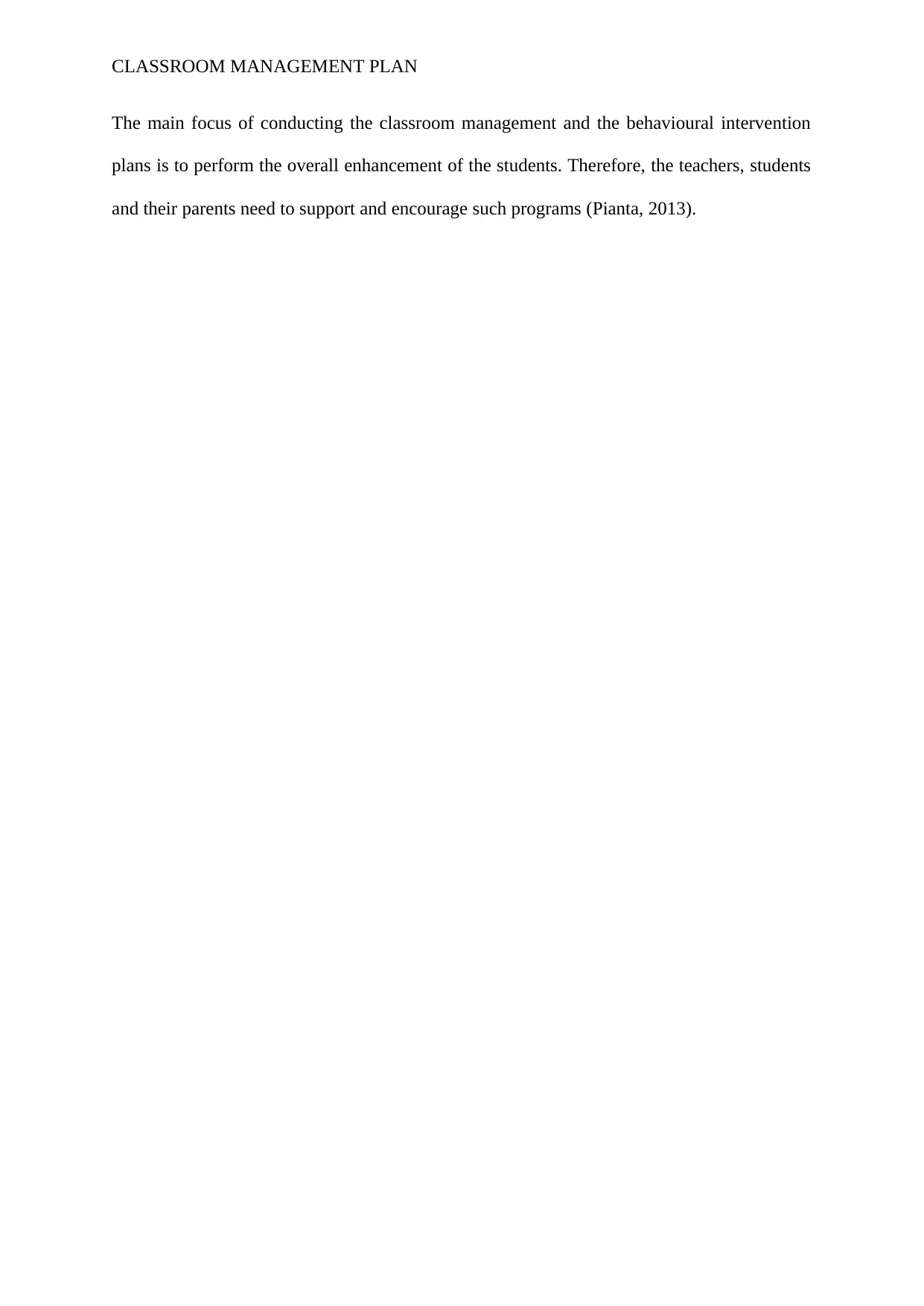
CLASSROOM MANAGEMENT PLAN
The main focus of conducting the classroom management and the behavioural intervention
plans is to perform the overall enhancement of the students. Therefore, the teachers, students
and their parents need to support and encourage such programs (Pianta, 2013).
The main focus of conducting the classroom management and the behavioural intervention
plans is to perform the overall enhancement of the students. Therefore, the teachers, students
and their parents need to support and encourage such programs (Pianta, 2013).
⊘ This is a preview!⊘
Do you want full access?
Subscribe today to unlock all pages.

Trusted by 1+ million students worldwide
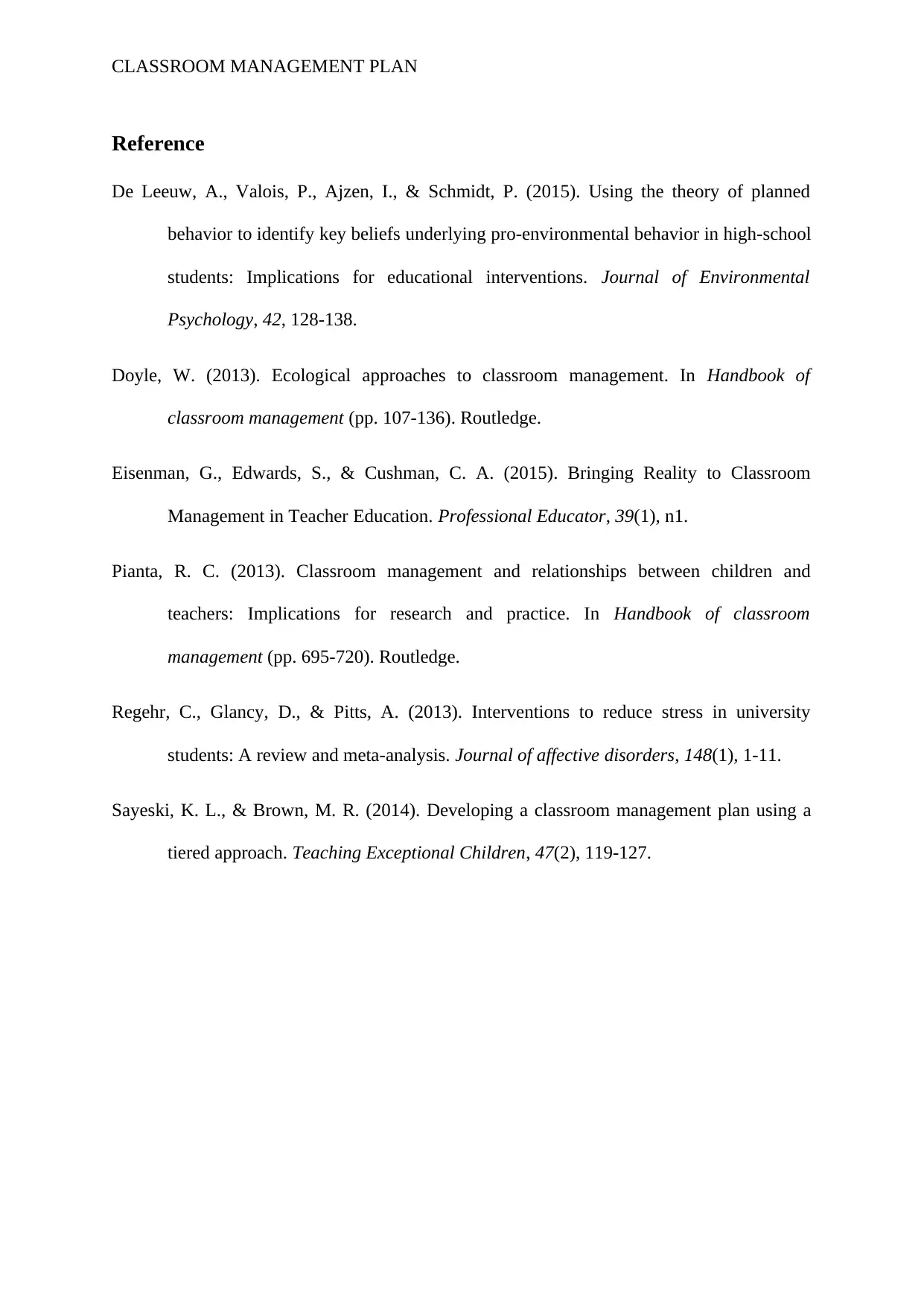
CLASSROOM MANAGEMENT PLAN
Reference
De Leeuw, A., Valois, P., Ajzen, I., & Schmidt, P. (2015). Using the theory of planned
behavior to identify key beliefs underlying pro-environmental behavior in high-school
students: Implications for educational interventions. Journal of Environmental
Psychology, 42, 128-138.
Doyle, W. (2013). Ecological approaches to classroom management. In Handbook of
classroom management (pp. 107-136). Routledge.
Eisenman, G., Edwards, S., & Cushman, C. A. (2015). Bringing Reality to Classroom
Management in Teacher Education. Professional Educator, 39(1), n1.
Pianta, R. C. (2013). Classroom management and relationships between children and
teachers: Implications for research and practice. In Handbook of classroom
management (pp. 695-720). Routledge.
Regehr, C., Glancy, D., & Pitts, A. (2013). Interventions to reduce stress in university
students: A review and meta-analysis. Journal of affective disorders, 148(1), 1-11.
Sayeski, K. L., & Brown, M. R. (2014). Developing a classroom management plan using a
tiered approach. Teaching Exceptional Children, 47(2), 119-127.
Reference
De Leeuw, A., Valois, P., Ajzen, I., & Schmidt, P. (2015). Using the theory of planned
behavior to identify key beliefs underlying pro-environmental behavior in high-school
students: Implications for educational interventions. Journal of Environmental
Psychology, 42, 128-138.
Doyle, W. (2013). Ecological approaches to classroom management. In Handbook of
classroom management (pp. 107-136). Routledge.
Eisenman, G., Edwards, S., & Cushman, C. A. (2015). Bringing Reality to Classroom
Management in Teacher Education. Professional Educator, 39(1), n1.
Pianta, R. C. (2013). Classroom management and relationships between children and
teachers: Implications for research and practice. In Handbook of classroom
management (pp. 695-720). Routledge.
Regehr, C., Glancy, D., & Pitts, A. (2013). Interventions to reduce stress in university
students: A review and meta-analysis. Journal of affective disorders, 148(1), 1-11.
Sayeski, K. L., & Brown, M. R. (2014). Developing a classroom management plan using a
tiered approach. Teaching Exceptional Children, 47(2), 119-127.
1 out of 7
Related Documents
Your All-in-One AI-Powered Toolkit for Academic Success.
+13062052269
info@desklib.com
Available 24*7 on WhatsApp / Email
![[object Object]](/_next/static/media/star-bottom.7253800d.svg)
Unlock your academic potential
Copyright © 2020–2025 A2Z Services. All Rights Reserved. Developed and managed by ZUCOL.





